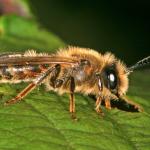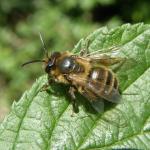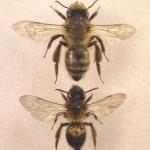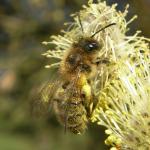Melitta trimmerana Kirby, 1802, Melitta spinigera Kirby, 1802, Andrena fusca Lepeletier, 1841, Andrena arietina Dours, 1872, Andrena ustulata Dours, 1872, Andrena lombardica Schmiedeknecht, 1883, Andrena dragona Friese, 1887, Andrena anglica Alfken, 1911
The map shows combined records for both A. scotia and A. trimmerana as these two species are very difficult to separate and so there exists much doubt about which records apply to which species.
This mining bee has both a spring and a summer brood. These differ morphologically, especially in the male (for example, first brood specimens have a strong, conspicuous genal spine which is lacking in summer brood individuals of this sex). In addition, second brood specimens are often more extensively marked with red on the basal tergites and sternites than their spring counterparts. It is possible that these broods are actually distinct species and research, involving the cytogenetics of each brood, is still ongoing. Indeed, the first brood was formerly considered to be a separate species, Andrena spinigera (Kirby) (e.g. Perkins, 1919).
East Kent to West Cornwall, north to the Midlands, with a somewhat isolated record from the Lake District. In Wales, known from the south and mainly coastal. It is also found in the Channel Islands. There are no records from Scotland. A record from Ireland mentioned by O’Connor et al. (2009) is probably an aberrant example of A. carantonica Pérez (= scotica Perkins). Scarce but often locally common where found.
Europe and west Asia, from the Netherlands south to Iberia and east to eastern Turkey and the former USSR; the species also occurs on the Balearics, Corsica, Sicily and Crete. It is also found in North Africa (Morocco and Algeria) (see Gusenleitner & Schwarz (2002) for map of the species’ distribution in the western Palaearctic).
The map shows combined records for both A. scotia and A. trimmerana as these two species are very difficult to separate and so there exists much doubt about which records apply to which species.
This species is not regarded as being scarce or threatened.
Generally distributed, having been recorded from coastal landslips and cliffs and, inland, from heaths, open woodland, chalk grassland, fens, commons and gardens.
Bivoltine; mid March to the end of April, and again from July to late September.
The species apparently nests singly, not in aggregations (Kocourek, 1966; Dylewska, 1987). In England, nests have been found in banks, slopes and bare vertical soil (e.g. Beavis, 2007). Communal nesting, as occurs in its close relatives, Andrena carantonica Pérez and A. bucephala Stephens, has not been confirmed for A. trimmerana.
It has been recorded from a buttercup, willows, bramble, rhododendron, blackthorn, gorse, alexanders and dandelion.
Nomada marshamella (Kirby) has been reported as a cleptoparasite of A. trimmerana (Perkins, 1919). Occasionally specimens are found which are stylopised, apparently by Stylops aterrimus Newport (Kinzelbach, 1971).
2023






